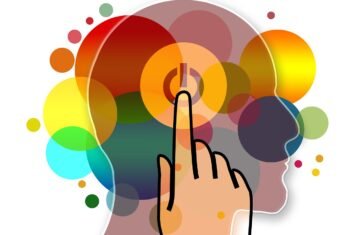Thinking about how we look affects how we feel. If we’re happy with the way we look, invariably we feel content. Conversely, being dissatisfied with our bodies and faces, brings us down.
Prevalence
It’s an issue I see all the time in therapy and this is echoed in a 2019 global survey by YouGov which found that 61% of adults across several countries reported feeling negatively about their body image.
The Mental Health Foundation in the UK reported in 2019 that one in five adults (20%) had experienced shame about their body in the past year, and 34% had felt anxious or depressed due to body image concerns.
For adolescents, the statistics can be even higher, with studies indicating that over 50% of teens in many Western countries are unhappy with their bodies.
Why do we focus on our bodies?
If we look at it objectively, the answer is obvious. How we look is the key to happiness because it brings us a mate.
Perhaps the biggest role we have as people, is to continue our species; it’s not a coincidence that sex is so pleasurable.
To attract a mate, we need to be attractive. Of course there is more to wanting a mate than procreation, it’s also nice to share our journeys and to give and receive support. We typically work better as a team.
But when we feel attractive and noticed by others, we feel good; it boosts our self-esteem and confidence.
We also want to fit in and if we look too different from those around us, we may feel like we don’t belong.
What we consider to be attractive, is likely partly evolutionary. Throughout history, certain physical traits were often associated with health, fertility, and survival, which may have made them more desirable in the context of selecting a partner. While modern society has evolved, these preferences can still subconsciously influence perceptions of attractiveness.
Why do some people need therapy for body image concerns?
So why is it that in my clinic, I see some people whose sole concern is how they look while for others, it’s not even on the agenda? Typically it’s younger people in their late teens that bring body image as an issue and those dating or in new relationships. The answer isn’t straightforward and it takes time to unravel. It’s often rooted in a blend of social, psychological, and personal factors.
Societal standards and media play a powerful role, as my clients are frequently exposed to idealised images in advertisements and social media, creating unrealistic standards of beauty. This constant comparison can lead to feelings of inadequacy, making them believe they do not measure up.
For many clients, low self-esteem and insecurity drive a focus on appearance. They often seek validation externally, hoping that improving their looks will boost their self-worth. Many have experienced bullying or critical comments about their appearance during childhood or adolescence, leaving them highly attuned to perceived flaws and feeling deeply vulnerable.
I also see how mental health conditions, such as anxiety, depression, or body dysmorphic disorder (BDD), amplify negative thoughts about appearance. Clients with these conditions often fixate on minor physical flaws, perceiving them as significant sources of distress.
Social pressures and fear of judgment add to the burden, especially for adolescents and those navigating significant life changes. This combination of factors can create a cycle where concerns about appearance dominate their self-worth and sense of social acceptance.
The early years
Early relationships play a big role in shaping how people view themselves and their bodies. Those who grew up feeling unsure about their worth or constantly seeking approval may become more sensitive to societal standards of beauty.
They might focus heavily on their appearance, believing it will help them gain acceptance or avoid rejection. Even those who tend to avoid relying on others can be preoccupied with maintaining a “perfect” look, using their appearance as a way to feel in control and hide their vulnerabilities.
People who have experienced trauma or unstable caregiving may have a conflicted relationship with their bodies, often seeing them as a source of distress. They might focus intensely on their appearance as a way to regain a sense of control over their lives. These tendencies can also be linked to higher risks of anxiety, depression, and extreme preoccupation with perceived flaws.
In contrast, those with a secure sense of self, often rooted in consistent and positive early relationships, tend to feel less pressure to meet unrealistic beauty standards. They are more likely to accept their bodies as they are, focusing less on appearance for validation and feeling less impacted by societal pressures about how they should look.
When is concern about body image a disorder?
As a psychotherapist, I help clients understand when concern about body image becomes a serious issue. Body image concerns are normal and often involve occasional dissatisfaction or comparisons, influenced by societal and media standards. These thoughts can fluctuate without significantly impacting daily life.
Body dissatisfaction is more persistent, involving ongoing negative feelings about one’s appearance or specific body parts. It can lead to unhealthy behaviors like excessive dieting or avoiding social situations but doesn’t usually cause severe daily impairment.
Body Dysmorphic Disorder (BDD) is a mental health condition where a person becomes obsessively focused on perceived flaws in their appearance, even if minor or invisible to others. This preoccupation often consumes hours each day, leading to repetitive behaviors like mirror-checking or seeking reassurance. BDD can severely impact social and professional life, sometimes resulting in social isolation or repeated cosmetic procedures without satisfaction.
When to seek help: Body dissatisfaction needs attention if it triggers harmful coping mechanisms or significantly impacts self-esteem. BDD requires professional intervention due to its link to severe anxiety and impaired functioning. If someone feels their focus on appearance is overwhelming and disruptive, seeking help is essential for their well-being.
Strategies for Body Acceptance and Reducing Obsession
Cognitive-behavioral therapy (CBT).
CBT is a powerful tool for reshaping negative thought patterns around body image. By learning to challenge and reframe negative self-talk, clients can replace self-critical thoughts with more balanced and realistic perspectives. Techniques like thought-restructuring help individuals recognise distorted thinking and develop a healthier relationship with their appearance. Practical Strategy: Practice replacing negative thoughts with positive affirmations, such as, “My body is more than its appearance; it is strong and capable.”
Mindfulness and Body Positivity Practices.
Mindfulness encourages clients to focus on their body’s abilities rather than its appearance, fostering a sense of gratitude and acceptance. Incorporating practices from body positivity and body neutrality movements can help clients build self-worth that isn’t dependent on looks. Activities like daily affirmations and grounding exercises can be effective in shifting towards a more compassionate view of oneself. Practical Strategy: Set aside time each day for a mindful body scan, focusing on the sensations in different parts of the body and what they allow you to do, like walking or hugging a loved one.
Limiting Social Media Exposure.
Curating a healthier social media experience can reduce the pressure to compare. This might include following body-positive influencers and unfollowing accounts that trigger negative feelings. Taking regular breaks from social media can also help clients become more present in their own lives, easing the comparison habit. Practical Strategy: Set a timer for social media use or designate “screen-free” times each day to focus on offline activities. Practical Day-to-Day Strategies: Simple daily habits can help reduce obsession with appearance.
Avoid excessive mirror-checking
Set a limit on how often you look at yourself each day—try to only check in the mirror when necessary, like for grooming.
Wear comfortable clothing
This should help you feel good in your own skin rather than focusing on how others might perceive you.
Redirect your focus
Engaging in activities you enjoy, such as hobbies, reading, or spending time with friends, can help shift attention away from appearance.
Seeking Professional Support.
Therapy and support groups are crucial for those facing intense body image struggles. Professional support from therapists and dietitians who emphasize intuitive eating and holistic well-being can guide clients toward a more balanced relationship with their bodies and food, supporting both mental and physical health. Practical Strategy: Reach out to a therapist or support group specialising in body image to gain structured guidance and a safe space to explore feelings about appearance.
Final Thoughts
Body image concerns are a common struggle, affecting people of all ages and backgrounds. While it’s natural to have moments of self-doubt about appearance, for some, these feelings can become overwhelming and affect their quality of life.
Societal pressures, personal history, and mental health conditions can all contribute to a negative relationship with one’s body. Understanding the difference between normal dissatisfaction, persistent negative self-evaluation, and serious conditions like Body Dysmorphic Disorder (BDD) is essential in determining when to seek support.
Fortunately, there are strategies that can help. Cognitive-behavioral techniques, mindfulness practices, and limiting exposure to social media can reduce the impact of appearance-focused thoughts. Adopting simple daily habits, like reducing mirror-checking and engaging in fulfilling activities, can shift focus away from appearance. And for those who need it, professional help provides a path toward healing, fostering a more positive and accepting relationship with one’s body.
Ultimately, learning to appreciate our bodies for their abilities rather than just their appearance can create a healthier, more balanced perspective—one that allows us to focus on what truly matters in our lives. But one word of warning, it takes work and determination to move to a place where we’re comfortable in our own skin. We have to do the work and persist. It is possible to achieve but it’s not something we can just manifest!










